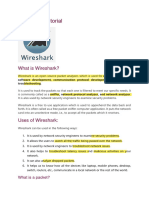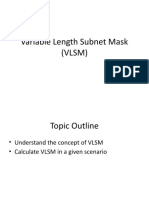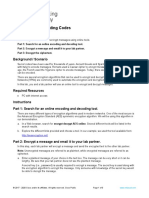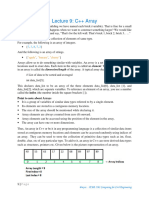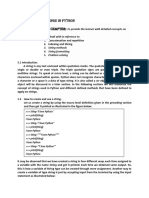0 ratings0% found this document useful (0 votes)
301 viewsDevice Interface Ip Address Subnet Mask Default-Gateway
Device Interface Ip Address Subnet Mask Default-Gateway
Uploaded by
Jr de GuzmanThe document contains an addressing table that lists the interfaces, IP addresses, subnet masks, and default gateways for devices in a network including routers R1 and R2, switches S1-S4, and PCs PC1-PC4. The table is used to design an IP addressing scheme for the network. A /24 network is subnetted into eight /27 subnets to support the required 25 hosts. The subnets are assigned to interfaces on the routers and switches according to the network topology.
Copyright:
© All Rights Reserved
Available Formats
Download as DOCX, PDF, TXT or read online from Scribd
Device Interface Ip Address Subnet Mask Default-Gateway
Device Interface Ip Address Subnet Mask Default-Gateway
Uploaded by
Jr de Guzman0 ratings0% found this document useful (0 votes)
301 views3 pagesThe document contains an addressing table that lists the interfaces, IP addresses, subnet masks, and default gateways for devices in a network including routers R1 and R2, switches S1-S4, and PCs PC1-PC4. The table is used to design an IP addressing scheme for the network. A /24 network is subnetted into eight /27 subnets to support the required 25 hosts. The subnets are assigned to interfaces on the routers and switches according to the network topology.
Original Description:
Take home quiz pkt
Original Title
Cirilene Take Home
Copyright
© © All Rights Reserved
Available Formats
DOCX, PDF, TXT or read online from Scribd
Share this document
Did you find this document useful?
Is this content inappropriate?
The document contains an addressing table that lists the interfaces, IP addresses, subnet masks, and default gateways for devices in a network including routers R1 and R2, switches S1-S4, and PCs PC1-PC4. The table is used to design an IP addressing scheme for the network. A /24 network is subnetted into eight /27 subnets to support the required 25 hosts. The subnets are assigned to interfaces on the routers and switches according to the network topology.
Copyright:
© All Rights Reserved
Available Formats
Download as DOCX, PDF, TXT or read online from Scribd
Download as docx, pdf, or txt
0 ratings0% found this document useful (0 votes)
301 views3 pagesDevice Interface Ip Address Subnet Mask Default-Gateway
Device Interface Ip Address Subnet Mask Default-Gateway
Uploaded by
Jr de GuzmanThe document contains an addressing table that lists the interfaces, IP addresses, subnet masks, and default gateways for devices in a network including routers R1 and R2, switches S1-S4, and PCs PC1-PC4. The table is used to design an IP addressing scheme for the network. A /24 network is subnetted into eight /27 subnets to support the required 25 hosts. The subnets are assigned to interfaces on the routers and switches according to the network topology.
Copyright:
© All Rights Reserved
Available Formats
Download as DOCX, PDF, TXT or read online from Scribd
Download as docx, pdf, or txt
You are on page 1of 3
DIEZ, CIRILENE
CPE 302 – CPE32FA1
TAKE HOME QUIZ
ADDRESSING TABLE
DEVICE INTERFACE IP ADDRESS SUBNET MASK DEFAULT-GATEWAY
G0/0 192.168.100.1 255.255.255.224 N/A
R1 G0/1 192.168.100.33 255.255.255.224 N/A
S0/0/0 192.168.100.129 255.255.255.224 N/A
G0/0 192.168.100.65 255.255.255.224 N/A
R2 G0/1 192.168.100.97 255.255.255.224 N/A
S0/0/0 192.168.100.158 255.255.255.224 N/A
S1 VLAN 1 192.168.100.2 255.255.255.224 192.168.100.1
S2 VLAN 1 192.168.100.34 255.255.255.224 192.168.100.33
S3 VLAN 1 192.168.100.66 255.255.255.224 192.168.100.65
S4 VLAN 1 192.168.100.98 255.255.255.224 192.168.100.97
PC1 NIC 192.168.100.30 255.255.255.224 192.168.100.1
PC2 NIC 192.168.100.62 255.255.255.224 192.168.100.33
PC3 NIC 192.168.100.94 255.255.255.224 192.168.100.65
PC4 NIC 192.168.100.128 255.255.255.224 192.168.100.97
SOLUTION:
Required host: 25
25 = 32 host total number of host addresses
25 – 2 = 30 host number of usable host
23 = 8 subnets total number of subnets
Part 1: Design an IP Addressing Scheme
Step 1: Subnet the 192.168.100.0/24 network into the appropriate number of subnets.
a. Based on the topology, how many subnets are needed? 5
b. How many bits must be borrowed to support the number of subnets in the topology
table? 3 bits
c. How many subnets does this create? 23 = 8 subnets
d. How many usable hosts does this create per subnet? 25 – 2 = 30 hosts
Note: If your answer is less than the 25 hosts required, then you borrowed too many
bits.
e. Calculate the binary value for the first five subnets. The first subnet is already shown.
Net 0: 192 . 168 . 100 . 0 0 0 0 0 0 0 0
Net 1: 192 . 168 . 100 . 00100000
Net 2: 192 . 168 . 100 . 01000000
Net 3: 192 . 168 . 100 . 01100000
Net 4: 192 . 168 . 100 . 10000000
f. Calculate the binary and decimal value of the new subnet mask.
11111111.11111111.11111111. 11100000
255 . 255 . 255 . 224
Subnet Number Subnet Address First Usable Host Last Usable Host Broadcast Address
Address Address
0 192.168.100.0 192.168.100.1 192.168.100.30 192.168.100.31
1 192.168.100.32 192.168.100.33 192.168.100.62 192.168.100.63
2 192.168.100.64 192.168.100.65 192.168.100.94 192.168.100.95
3 192.168.100.96 192.168.100.97 192.168.100.126 192.168.100.127
4 192.168.100.128 192.168.100.129 192.168.100.158 192.168.100.159
5 192.168.100.160 192.168.100.161 192.168.100.190 192.168.100.191
6 192.168.100.192 192.168.100.193 192.168.100.222 192.168.100.223
7 192.168.100.224 192.168.100.225 192.168.100.254 192.168.100.255
Step 2: Assign the subnets to the network shown in the topology.
a. Assign Subnet 0 to the LAN connected to the GigabitEthernet 0/0 interface of R1: 192.168.100.0 /27
b. Assign Subnet 1 to the LAN connected to the GigabitEthernet 0/1 interface of R1: 192.168.100.32 /27
c. Assign Subnet 2 to the LAN connected to the GigabitEthernet 0/0 interface of R2: 192.168.100.64/27
d. Assign Subnet 3 to the LAN connected to the GigabitEthernet 0/1 interface of R2: 192.168.100.96 /27
e. Assign Subnet 4 to the WAN link between R1 to R2: 192.168.100.128 /27
You might also like
- Lab 2b-RSA Public-Key Encryption and Signature LabDocument10 pagesLab 2b-RSA Public-Key Encryption and Signature LabPranavNo ratings yet
- Lab 2Document26 pagesLab 2Rishabh Gupta100% (1)
- 2.5.5 Configure Initial Switch Settings QuisaguanoDocument7 pages2.5.5 Configure Initial Switch Settings QuisaguanoFernandoQuisaguanoNo ratings yet
- Challenging Subnetting To AnswerDocument3 pagesChallenging Subnetting To AnswerscribdtrackNo ratings yet
- Crypto LabDocument7 pagesCrypto LabRiza Fahmy100% (1)
- Wireshark Lab: ICMP v7.0: 1 ObjectiveDocument4 pagesWireshark Lab: ICMP v7.0: 1 ObjectiveHugo GustavoNo ratings yet
- Quiz For Chapter 3 With Solutions PDFDocument8 pagesQuiz For Chapter 3 With Solutions PDFSiddharth SinghNo ratings yet
- How To Use SIC Simulator and AssemblerDocument12 pagesHow To Use SIC Simulator and AssemblerMena SamehNo ratings yet
- Network ExerciseDocument3 pagesNetwork ExerciseSundari MuthuNo ratings yet
- VLSM Subnetting Explained With ExamplesDocument5 pagesVLSM Subnetting Explained With ExamplesDervpolo Vans100% (1)
- Data Communications: MultiplexingDocument49 pagesData Communications: MultiplexingAkram TahaNo ratings yet
- Feleke - IP - Address - Subnetting - 2024Document49 pagesFeleke - IP - Address - Subnetting - 2024EnoughNo ratings yet
- 2-4 Variable Length Subnet Masks (VLSM) - Free CCNA Study GuideDocument3 pages2-4 Variable Length Subnet Masks (VLSM) - Free CCNA Study GuideRobin RohitNo ratings yet
- Review Questions: Identify The Five Components of A Data Communications System?Document46 pagesReview Questions: Identify The Five Components of A Data Communications System?DARIUSNo ratings yet
- Wireshark TutorialDocument32 pagesWireshark Tutorialdeepaknagda285No ratings yet
- Variable Length Subnet Mask (VLSM)Document22 pagesVariable Length Subnet Mask (VLSM)Jeyanthi GovindasamyNo ratings yet
- Addressing ModesDocument12 pagesAddressing ModesAbdul Rafay HammadNo ratings yet
- Spanning TreeDocument7 pagesSpanning TreeajithNo ratings yet
- HW9 SolDocument3 pagesHW9 SolTài LâmNo ratings yet
- SUMAYAN Activity No 8 Attributes - 1Document13 pagesSUMAYAN Activity No 8 Attributes - 1brian sebastianNo ratings yet
- COMP 552 Introduction To Cybersecurity Winter 2022: Page 1 of 3Document3 pagesCOMP 552 Introduction To Cybersecurity Winter 2022: Page 1 of 3SravyaNo ratings yet
- Wireshark Lab 02 - HTTPDocument17 pagesWireshark Lab 02 - HTTPCarlos HenriqueNo ratings yet
- Variable Length Subnet MaskDocument6 pagesVariable Length Subnet MaskmidoNo ratings yet
- 6 - Signal Flow GraphsDocument59 pages6 - Signal Flow GraphsSuyash Dahake VlogsNo ratings yet
- Error Detection and CorrectionDocument38 pagesError Detection and CorrectionKipkirui TopiasNo ratings yet
- Python Programming LabDocument45 pagesPython Programming LabTrilochan PanigrahiNo ratings yet
- Fundamentals of Data Science Lab ManualDocument34 pagesFundamentals of Data Science Lab ManualragunathNo ratings yet
- Python Lab ManualDocument19 pagesPython Lab ManualmanyamdwdNo ratings yet
- File Handling in Python (Binary Files)Document11 pagesFile Handling in Python (Binary Files)VidushiNo ratings yet
- Chapter 2:instructions: Language of The ComputerDocument81 pagesChapter 2:instructions: Language of The ComputerGreen ChiquitaNo ratings yet
- 21.0.3 Class Activity - Creating CodesDocument3 pages21.0.3 Class Activity - Creating Codesbui lamNo ratings yet
- A Step by Step Guide To SubnettingDocument4 pagesA Step by Step Guide To SubnettingRudren Eswaran KrishnanNo ratings yet
- VLSM ExercisesDocument17 pagesVLSM ExercisesAishwary AgrahariNo ratings yet
- CCNA4 Lab 1 2 6Document6 pagesCCNA4 Lab 1 2 6Alexandra AlmeidaNo ratings yet
- ITC Python ProgramsDocument8 pagesITC Python ProgramsHafeez AliNo ratings yet
- IP AddressingDocument27 pagesIP Addressingparthasn83No ratings yet
- Fork System CallDocument3 pagesFork System Callrose marine100% (1)
- 15 Mis 0265 CN1Document15 pages15 Mis 0265 CN1Pothu LokeshNo ratings yet
- Activity No 7 ProcedureDocument7 pagesActivity No 7 Procedurealex sandersNo ratings yet
- Question Bank Unit 4 - 5 - 6Document7 pagesQuestion Bank Unit 4 - 5 - 6Piyush TembhurneNo ratings yet
- Subnetting Exercises AnswersDocument3 pagesSubnetting Exercises AnswersZekarias HailuNo ratings yet
- Lecture 9-C++ ArraysDocument19 pagesLecture 9-C++ ArraysorodizodanieloNo ratings yet
- CA ch2Document14 pagesCA ch2Llazi LegjendaNo ratings yet
- Ch04 Crypto7eDocument23 pagesCh04 Crypto7eQosai ZoubiNo ratings yet
- IPSec AssignmentDocument6 pagesIPSec Assignmentmehdi13994No ratings yet
- Strings in PythonDocument30 pagesStrings in PythonAnil Bikash ChowdhuryNo ratings yet
- Dijkstra Algorithm PDFDocument24 pagesDijkstra Algorithm PDFsudhan100% (1)
- CCNA Security 1.0.1: Student Packet Tracer ManualDocument40 pagesCCNA Security 1.0.1: Student Packet Tracer Manualwejooo100% (1)
- Objective: For This Lab You Will Run Your Assembly Programs With PcspimDocument8 pagesObjective: For This Lab You Will Run Your Assembly Programs With PcspimsmalldragonvtNo ratings yet
- Activity 5Document8 pagesActivity 5Anonymous RO0RYTAIZpNo ratings yet
- Chapter Two (Part 2) Data Link Layer Protocols (Q & A)Document14 pagesChapter Two (Part 2) Data Link Layer Protocols (Q & A)رسول ابراهيم عبد علي رويعيNo ratings yet
- Cisco CCENT Practice and Study Guide - Subnetting IP Networks - Subnetting An IPv4 NetworkDocument7 pagesCisco CCENT Practice and Study Guide - Subnetting IP Networks - Subnetting An IPv4 Networkkim pavilario0% (1)
- INTERNET PROTOCOL VERSION 4 (IPV4) PresentationDocument9 pagesINTERNET PROTOCOL VERSION 4 (IPV4) PresentationGavin Mudyiwa0% (1)
- Assignment 2b. Programming FundamentalsDocument1 pageAssignment 2b. Programming FundamentalschitranshpandeyNo ratings yet
- Week 13 PT Activity 2-LAPINIGDocument3 pagesWeek 13 PT Activity 2-LAPINIGXÏX LXÏXNo ratings yet
- DinhDucTaiDocument5 pagesDinhDucTaiĐinh Đức TàiNo ratings yet
- 8.1.4.7 Packet Tracer - Subnetting ScenarioDocument6 pages8.1.4.7 Packet Tracer - Subnetting ScenarioHuy Giang VănNo ratings yet
- 11.7.5-Packet-Tracer - Subnetting-ScenarioDocument5 pages11.7.5-Packet-Tracer - Subnetting-Scenariostudy timeNo ratings yet
- 11.7.5-packet-tracer - -subnetting-scenario_chittesh_sDocument3 pages11.7.5-packet-tracer - -subnetting-scenario_chittesh_schittesh8877No ratings yet
- 11.7.5-Subnetting ScenarioDocument6 pages11.7.5-Subnetting Scenariotuanminh261204No ratings yet
- Project Proposal4Document2 pagesProject Proposal4Jr de GuzmanNo ratings yet
- NotesDocument1 pageNotesJr de GuzmanNo ratings yet
- Assign1 LogiccrtDocument4 pagesAssign1 LogiccrtJr de GuzmanNo ratings yet
- Technological Institute of The Philippines 1338 Arlegui ST., Quiapo, ManilaDocument1 pageTechnological Institute of The Philippines 1338 Arlegui ST., Quiapo, ManilaJr de GuzmanNo ratings yet
- Seatwork EEco AnnuityDocument17 pagesSeatwork EEco AnnuityJr de GuzmanNo ratings yet
- Technological Institute of The Philippines 1338 Arlegui ST., Quiapo, ManilaDocument2 pagesTechnological Institute of The Philippines 1338 Arlegui ST., Quiapo, ManilaJr de GuzmanNo ratings yet
- Kinematics (Application of Differentiation and Integration) QuestionsDocument7 pagesKinematics (Application of Differentiation and Integration) QuestionsJr de GuzmanNo ratings yet
- Activity No. 1: Ten (10) Solved Problems About Motion of Rigid Bodies Along X - AxisDocument3 pagesActivity No. 1: Ten (10) Solved Problems About Motion of Rigid Bodies Along X - AxisJr de GuzmanNo ratings yet
- De Guzman, J.R. T. CPE 505 - CPE51FA2: Social IssuesDocument2 pagesDe Guzman, J.R. T. CPE 505 - CPE51FA2: Social IssuesJr de GuzmanNo ratings yet
- 09 Electricity & Kirchhoffs RulesDocument8 pages09 Electricity & Kirchhoffs RulesJr de GuzmanNo ratings yet
- Technological Institute of The Philippines 1338 Arlegui ST., Quiapo, ManilaDocument1 pageTechnological Institute of The Philippines 1338 Arlegui ST., Quiapo, ManilaJr de GuzmanNo ratings yet
- Case StudiesDocument7 pagesCase StudiesJr de GuzmanNo ratings yet
- Archdiocese of Lingayen-Dagupan Catholic Schools Saint Charles Academy Malong St. San Carlos City, Pangasinan S.Y. 2014-2015Document1 pageArchdiocese of Lingayen-Dagupan Catholic Schools Saint Charles Academy Malong St. San Carlos City, Pangasinan S.Y. 2014-2015Jr de GuzmanNo ratings yet
- SDH Topologies and UpgradesDocument36 pagesSDH Topologies and UpgradesshariqNo ratings yet
- IM7200 Quick Start Guide: 01. Check The Kit's Contents Are CompleteDocument4 pagesIM7200 Quick Start Guide: 01. Check The Kit's Contents Are CompleteMiro JanosNo ratings yet
- List of TCP and UDP Port NumbersDocument38 pagesList of TCP and UDP Port NumbersHamdi KadriNo ratings yet
- Dhiman Ghosh - IMMDocument2 pagesDhiman Ghosh - IMMJayaraj TNo ratings yet
- Edr-G900 Series Um 2eDocument79 pagesEdr-G900 Series Um 2ejuan manuelNo ratings yet
- SP DNS Security Solution EfficientIP EN 181004Document6 pagesSP DNS Security Solution EfficientIP EN 181004Monirul IslamNo ratings yet
- B. Prashanth - CN Lab Manual (R22).Docx (2) (1)Document43 pagesB. Prashanth - CN Lab Manual (R22).Docx (2) (1)227r1a7309No ratings yet
- Practice MTCREDocument7 pagesPractice MTCREJosé Lino TeixeiraNo ratings yet
- Kozumi AFO5Document20 pagesKozumi AFO5Redes TelNetNo ratings yet
- Sip Messages and Call FlowsDocument37 pagesSip Messages and Call FlowsSanyam Singla100% (3)
- Guihy 78Document13 pagesGuihy 78pranavakushNo ratings yet
- Digital NetworksDocument10 pagesDigital Networksafrazulfiqar954No ratings yet
- 11.3.1.1 Packet Tracer - Skills Integration ChallengeDocument6 pages11.3.1.1 Packet Tracer - Skills Integration ChallengeShamsul ArefinNo ratings yet
- Data Sheet: - Non-Blocking Switching Fabric - Throughput Capacity 176 GbpsDocument5 pagesData Sheet: - Non-Blocking Switching Fabric - Throughput Capacity 176 GbpsHuy DoanNo ratings yet
- Tyco A Acn Micro Project 24-25Document3 pagesTyco A Acn Micro Project 24-25dilipnawale27No ratings yet
- 2.1.1.1 Describe An Edge Router:: CCNA Security Chapter 2 Securing Network DevicesDocument21 pages2.1.1.1 Describe An Edge Router:: CCNA Security Chapter 2 Securing Network DevicesDark RoseNo ratings yet
- 02 8.3.1.2 Packet Tracer - CCNA Skills Integration Challenge Instructions - ILMDocument12 pages02 8.3.1.2 Packet Tracer - CCNA Skills Integration Challenge Instructions - ILMIngrid RodriguezNo ratings yet
- CH 5 Network Layer CongestionDocument42 pagesCH 5 Network Layer CongestionDaryl ShaverNo ratings yet
- FL Dcnx7k31 Lg314Document270 pagesFL Dcnx7k31 Lg314mohamed outalebNo ratings yet
- 3.1.2.7 Packet Tracer - Investigating A VLAN Implementation PDFDocument4 pages3.1.2.7 Packet Tracer - Investigating A VLAN Implementation PDFEDGAR ADRIAN VILLEGAS LOERANo ratings yet
- Cisco IOS 12.4 Config CRDocument1,070 pagesCisco IOS 12.4 Config CRCarlos MartinezNo ratings yet
- TRACS Site Details Form RevF-3Document4 pagesTRACS Site Details Form RevF-3cassio.vlmNo ratings yet
- Aerohive Datasheet XR200PDocument2 pagesAerohive Datasheet XR200PjuharieNo ratings yet
- Isr4k Rel Notes Xe 17 12Document11 pagesIsr4k Rel Notes Xe 17 12ceterelNo ratings yet
- Subnetting ProblemsDocument4 pagesSubnetting ProblemsSooraj SNo ratings yet
- Faqs - Jio High Speed Internet (Hsi)Document8 pagesFaqs - Jio High Speed Internet (Hsi)sandip mishraNo ratings yet
- Computer Networks - (EC602PCC-CS602 PCCCS602) - 6596 - I040Document1 pageComputer Networks - (EC602PCC-CS602 PCCCS602) - 6596 - I040sekharpaswan2001No ratings yet
- Phoneway - All Models Manual - V-1-0Document104 pagesPhoneway - All Models Manual - V-1-0PauloSNo ratings yet
- Lab 4 Group 1ADocument16 pagesLab 4 Group 1AhariNo ratings yet
- Plantilla VoIPDocument20 pagesPlantilla VoIPAlejandro Garcia StaceyNo ratings yet














